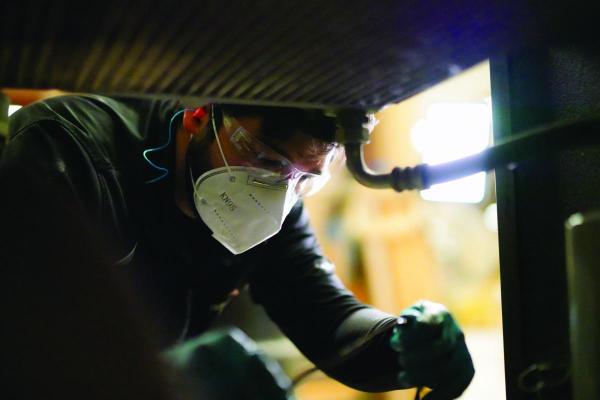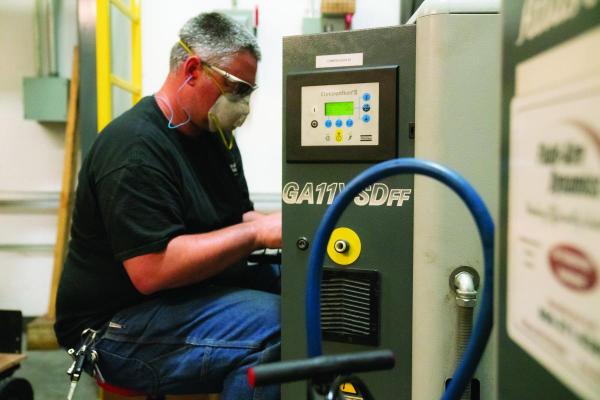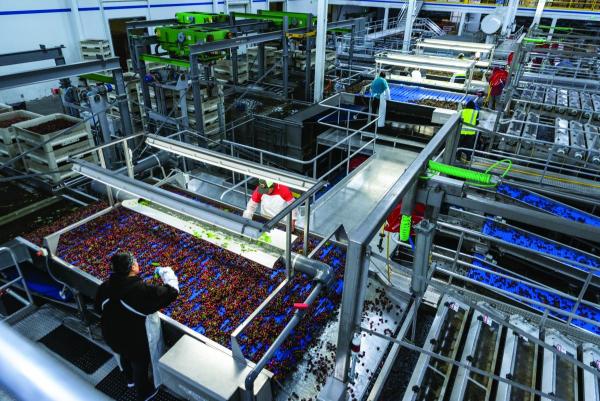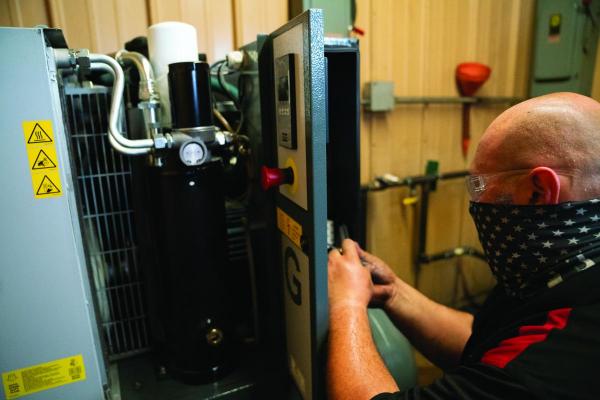No one knows when the Corona virus pandemic will officially end, yet one thing for certain is the high level of professionalism demonstrated time and again by manufacturers and distributors across the compressed air industry during one of the worst global crises in modern times.
Those in the industry reacted swiftly to protect employees and support their families. They did what it took to safely keep essential businesses up and running. They found efficient ways to conduct business and get things done. And they thought of others and how they can help.
In summary, the industry not only rallied through an immensely difficult time; it rose above it.

Companies from all corners of the compressed air industry rose above the COVID-19 pandemic to support employees, partners and customers. (Photo courtesy of Fluid-Aire Dynamics.)
Employee and Customer Safety Comes First
In late January, the World Health Organization declared coronavirus (later called COVID-19) a public health emergency of international concern. Later, the president of the United States declared a national emergency to fight COVID-19.
As the crisis unfolded, manufacturers and distributors of compressed air and vacuum systems took the necessary steps and precautions using guidance from the Centers for Disease Control and other agencies to minimize the spread of the virus, while continuing to support customers. At all times the top priority was the safety and wellbeing of employees and their families, as well as partners and customers.
At Kaeser Compressors, the goal early on was to help employees throughout the company’s global operations feel safe and confident during a time of uncertainty.
“A fear among employees and customers was the existential fear of losing your job and everything you’ve worked hard for. We had to take that fear away,” said Frank Mueller, President of Kaeser Compressors, Inc., in describing a key message shared by Kaeser Kompressoren Chairman Thomas Kaeser and other company leaders in the early stage of the COVID-19 crisis. “We let people know we will come out of this whole and together and that we’re in a strong position to do it. Whether it takes place over weeks or months we wanted them to know they will continue to have a livelihood. We also asked them to be brave and take the appropriate precautions.”
Sullair, LLC, is another example of a company that made employees the top priority. That message came through loud and clear early on from Sullair’s parent company Hitachi Group, said David Andrews, Senior Director, Marketing and Communications, Sullair.
“The very first words from Hitachi President and CEO Toshiaki Higashihara were, ‘I want to make sure you and your family are safe,’ ” said Andrews. “Hearing that made me proud to work for Sullair and to be a part of Hitachi.”
Manufacturers and distributors alike took unprecedented steps to ensure employee safety. Those who could work remotely were asked to do so. Video conferencing took the place of face-to-face meetings. Most gave employees the option to remain home, especially if they or family members were at high risk. Those who needed to be onsite took precautions, ranging from social distancing to hand washing to wearing protective masks and more.
All the while, production and service and repair operations looked very different than usual in the effort to protect employees. Sullair‘s manufacturing plant in Michigan City, Indiana, for example, normally operates a single shift. However, the company switched to a double shift during the early days of the crisis to create space between employees at the plant.
“It’s not an easy thing to do with such a large workforce, but our employees responded quickly and we were able to transition smoothly to a two-shift operation,” said Jessica Bailey, Senior Director of Human Resources, Sullair. “We knew it would be disruptive to our employees’ lives, but it was an important measure to keep our employees safe.”
Like manufacturers, employees needs were everything to distributors. An example is J.P.L. Compressor Service, Inc., Westminster, California. When a customer needed immediate assistance with their compressed air system early in the crisis, J.P.L. Compressor Service Co-owner and Senior Mechanical Engineer Joe Lester asked for volunteers to travel overnight to tackle the project. One service technician quickly volunteered but expressed concern about his family’s needs while he was out of town. Lester told the employee he’d see to it.
“His family was running low on essentials like everyone else,” Lester said. “I told him that I’d take care of it. So, I drove to the store, stood in line, and drove back to deliver the items to his wife. I just didn’t want him to have to worry about it, you know?”
Service and Support Remains Steadfast
Choose any point in time during the crisis and distributors and manufacturers said the need for services remained at a high level. All made sure their customers understood they were there for them when needed.

Service technicians took extra steps to ensure the safety of customers when servicing compressed air systems during the COVID-19 crisis. (Photo courtesy of Fluid-Aire Dynamics.)
“We noticed how important compressed air is to the general infrastructure since we saw very little drop in the level of service calls,” said Mueller at Kaeser. “It hammered home the point that compressed air is the fourth utility. Nothing happens without compressed air.”
Selecting & Sizing Oil-Free Air Compressors – Webinar RecordingDownload the slides and watch the recording of the FREE webcast to learn:
|
Derrick Taylor, Director of Fluid-Aire Dynamics, Schaumburg, Illinois, said some customers initially wanted to fully limit access to their facility, but soon changed their minds.
“It wasn’t long before they recognized that if they don’t maintain their compressed air systems, they’re going to be shutting their doors for a different reason,” Taylor said.
To ensure an uninterrupted flow of products and services, manufacturers and distributors ensured their shelves were fully stocked with supplies and spare parts. They wasted no time in communicating the need for their suppliers to support them as essential businesses. None left anything to chance.
“Our distributors’ customers were most interested in aftermarket parts and services and ensuring we could deliver what they needed to keep them up and running,” said Sullair’s Andrews. “When it came to our aftermarket operations, we not only had a backup plan to our normal backup plan, but we had another backup plan.”
Robert Eshelman, President, Atlas Copco Compressors USA, said advanced preparation for any unknown crisis played a key role in Atlas Copco’s ability to provide support throughout the pandemic.
“We can’t honestly say we planned for this eventuality, but our business continuity planning, which we put such high-priority on, really kicked in and we were able to become a fully functioning virtual organization almost overnight,” Eshelman said. “And thanks to our people we’re proud to have been able to provide support in terms of getting some really critical applications up and running in a really short space of time.”
Service technicians across the country took numerous precautions to ensure safety when serving compressed air systems. Typically, only one technician was sent to a job site; not two even when required. Rather than entering the facility through the front door, service technicians went directly to the compressor room after clearing it with the customer by cell phone. They also conducted system maintenance during the weekends at times, rather than weekdays.
End-users also took precautionary steps to maintain production. Many didn’t hesitate to contact compressed air distributors to communicate their need for support.
“We heard from a lot of companies that declared Zorn Compressor an essential business because we are an important part of their supply chain. They basically said, ‘We’re counting on you to keep the doors open,’ ” said Jeff Carlson, Vice President/General Manager of Zorn Compressor & Equipment, Pewaukee, Wisconsin.
The message CompressAir, LaPorte, Indiana, communicated to customers was straight forward. It also echoed the sentiments of most throughout the industry.
“We wanted customers to know we’re staying safe and healthy so we can be there for them. Throughout this pandemic we wanted them to know we’re going to stay open and fully operational,” said Andy Crowl, Owner of CompressAir.
Manufacturers and distributors also encouraged users of compressed air to continue to care for their compressed air systems during the crisis. As an example, PneuTech USA held a popular webinar during the crisis about things companies can do to improve a compressed air system at little to no cost and achieve tremendous savings. Examples include preventive maintenance and leak repair.
“We wanted to provide more value to customers in any way we could during the crisis,” Derrick Taylor said. “These are things they could do at that time to reduce their overhead and improve the system efficiency. That hopefully will put them in a better position when the pandemic is over with.”
|
How to Restart a Dormant Air Compressor “How do I start up my compressed air system after prolonged stoppage?”That was a popular question among users of compressed air throughout the COVID-19 crisis. Here’s advice from two compressed air service providers on the topic: “The definition of prolonged stoppage in the air compressor world is really dependent on the geographical location of the installation,” said Carlson of Zorn Compressor & Equipment. “A damp, humid climate could mean as soon as two to three weeks, whereas a relatively dry climate could be three months or more.” Carlson said a necessary precaution when an air compressor is down for a long period is to turn over the airend and motor by hand during the downtime to avoid potential for rust on the airend and/or motor bearings. When starting the machine after a prolonged period, Carlson recommends checking all electrical connections, air connections and fluid levels. He also recommends draining water from tanks/drip legs/filters and cleaning components that need to be cleaned. Another tip is to power-on the equipment and run under a load to make sure the operation and safety controls are functioning as they should. Then check the unit for proper temperature and see if any leaks have developed. Sometimes hoses and connections can dry out or crack if not in use. Carlson said it’s important to perform these procedures and checks, before production starts, to prevent compressed air problems from causing potential downtime. Like Carlson, Crowl at CompressAir said it’s important to quantify the length of stoppage and to know more about an end-user’s routine maintenance practices. “The first question we ask customers, who want to start-up a compressed air system after it has prolonged stoppage, is when was the last time it had preventive maintenance,” Crowl said, noting the answer will help determine the proper procedures. “It’s important to ask about preventive maintenance because the filters, controls and oil could be dirty and corroded if it has been a long time or if the machine has sat a while,” he said. “These are parts of the machine that provide clean air and have a major impact on the dependability of the machine.” Crowl suggests changing the oil, air filter, oil filter, and separator, and greasing and cleaning the controls on the air compressor. On the dryer, he recommends changing the pre- and after filters. Then, he said, it’s important to ensure the machine’s controls all set correctly for what is needed in production. |
Uptime the Only Option for Many
From the beginning of the COVID-19 crisis, company after company didn’t just talk the talk of providing service and support; they walked the walk knowing downtime wasn’t an option.

Sullair air compressors helped essential businesses maintain production throughout the pandemic, such as this food and beverage operation in the state of Washington. (Photo courtesy of Sullair.)
“We work with a division of the CDC that certifies breathing air ventilators,” said Eric Solverson, Vice President of Total Equipment Company (TEC), Coraopolis, Pennsylvania. “They were having issues over the weekend with an older air compressor. We had multiple technicians there within two hours late on a Saturday night. Luckily, they lost no production time.”
In Minnesota, an internationally recognized hospital saw the need for additional medical air for ventilator patients early in the crisis. The institution wanted to prepare for a potential influx of patients, said Brian Antony, Senior Vice President, JHFoster, Eagan, Minnesota.
“Mid-morning on a Friday we calculated the additional air capacity needed,” Antony said. “By the following Wednesday we assisted in the installation of a 20-horsepower (hp) air compressor. The hospital was relieved and excited. They sent an email saying they couldn’t believe how quickly we responded.”
At JHFoster, nine of the company’s 20 service technicians are credentialed to the American Society of Sanitary Engineering (ASSE) requirements of “ASSE 6040, Professional Qualification Standard for Medical Gas Maintenance Personnel.” The certification, which is required by NFPA 99 - Healthcare Facilities Code, signifies a technician is proficient and experienced in the maintenance of medical gas and vacuum systems.
In the Chicago area, healthcare decision-makers also took no chances with a potential increase in ventilator patients. But they needed help after re-opening a dormant hospital and put a call into CompressAir.
“We had a new installation that was to start up that day, but we needed to adjust our service technician’s schedule because of the importance of this situation,” Crowl said. “We went ahead and sent two technicians to the facility to make sure everything was running properly.”
A near crisis at an air separation plant took precedence for J.P.L. Compressor Service in California. The plant provides liquified oxygen to local hospitals and other healthcare facilities for use with ventilators. When a motor failed on an 800-hp centrifugal air compressor feeding the plant, J.P.L. Compressor Service immediately dispatched two technicians to the plant at 3 a.m. to drive 16 hours to the jobsite in separate trucks.
“Without that feed unit, they make zero oxygen. That means they would’ve had to ramp up another plant to make up for it and truck the oxygen that much farther to where it’s needed,” said Lester, noting the plant was back up and running within two days. “It makes me proud to have employees who were willing to make sure other people had oxygen at this difficult time.”
During the crisis, many industries in addition to the medical field required attention from compressed air companies.
Such was the case for a Fluid-Aire Dynamics’s customer in the vitamin supplement industry. The company didn’t encounter a maintenance or service issue. Instead, it needed to keep up with demand. That meant working creatively to install an entire backup compressed air system during the pandemic.
“Their business has increased significantly and we were able to ensure they have what they needed to ensure 100% redundancy in their system, despite the challenges of the virus,” said Kevin Taylor, General Manager of Fluid-Aire Dynamics.

Compressed air professionals did what needed to be done throughout the pandemic to keep their customers up and running. (Photo courtesy of Fluid-Aire Dynamics.)
The True Meaning of Customer Care
Throughout the pandemic, manufacturers and distributors truly demonstrated the meaning behind customer care.
While service technicians did their part, others worked from home, or in sparsely populated offices, to keep their operations running and to ensure customers’ needs were met. Sales teams put site visits on hold, opting for video conferencing and phone calls instead. Many sales reps delivered parts to customers when others couldn’t, while naturally taking the necessary safety precautions.
Manufacturers and distributors alike said the key to working through the COVID-19 crisis was to focus on the right thing to do.
“The biggest thing is really, just providing care,” said Carlson of Zorn Compressor & Equipment. “It’s about people in leadership roles stepping up and helping to keep morale up.”
Kevin Taylor at Fluid-Aire Dynamics could not agree more, explaining how one customer was despondent about the state of business. When talking with the customer, Taylor focused on the positive.
“I said, ‘Look, there’s a light at the end of the tunnel. This is going to pass and the economy will come back.’ By the end of the call, the customer said he felt better. What people need now is to remain optimistic and hopeful. That will go a long way in the future.”
Many in the industry not only remained hopeful throughout the crisis, but also found ways to be helpful.
At Atlas Copco USA, for example, employees helped meet the increased need for clean drinking water during the crisis by donating water to the Food Bank of the Rockies in Colorado. The initiative is part of Atlas Copco USA’s Water-for-All program in partnership with Can’d Aid. Additionally, Atlas Copco Comptec in Voorheesville, New York, supported local first responders by using the facility’s 3D printers to create face masks and face shields. Atlas Copco Comptec is a U.S.-based business unit of Atlas Copco’s Gas and Process division.
Sullair, meanwhile, found it had extra face masks in stock thanks to operations in Asia moving past the worst of the crisis and sending them to the Michigan City plant. Sullair donated the masks to a local healthcare provider. Some Sullair employees also took time out their personal schedules to sew masks for first responders.
Amber Brown and Kelly Molchan of the Sullair Human Resources team sew masks on their personal time for first responders, following critical shortages during the COVID-19 crisis. (Photo courtesy of Sullair.)
Andrews of Sullair said the COVID-19 crisis is unlike anything most have ever experienced, making it especially important to provide support to all involved.
“Unlike the financial crisis in the early 2000s, no one had a playbook for this crisis,” Andrews said. “The first thing our company did was to take care of employees and families. That to me, is a huge thing. I think people you have been loyal to through this crisis will be loyal to you when we come out of this.”
Air Compressor Technology Monthly e-NewsletterWith a focus on Supply-Side Optimization, air compressor technologies and compressor control systems are profiled. System Assessment articles detail what compressor controls allow kWh consumption to match system demand. |
To read more Compressed Air System Assessments articles, please visit www.airbestpractices.com/system-assessments.




